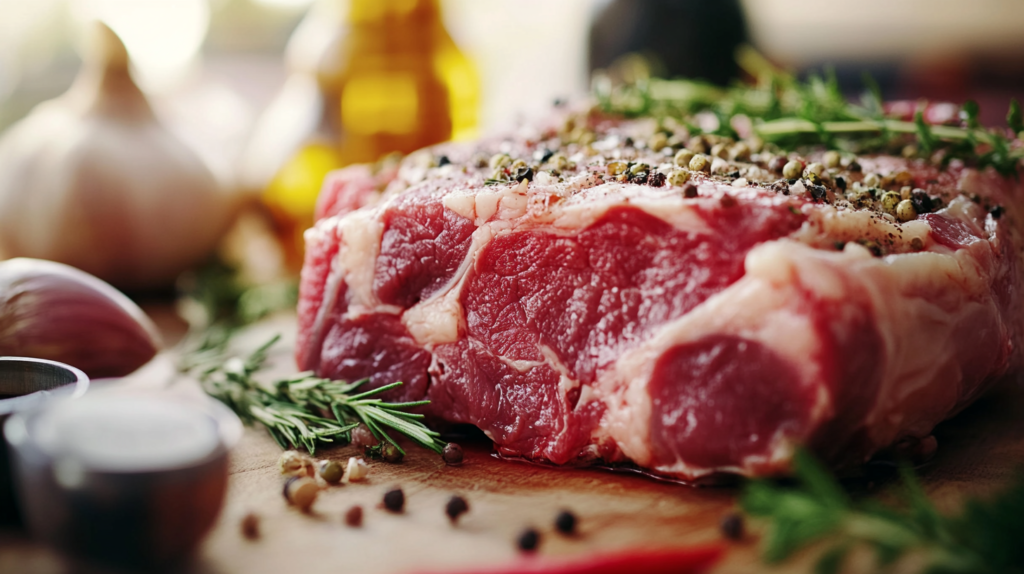Introduction to Meat Stock
Meat Stock Recipe is a versatile and nutritious base for countless recipes. Whether you’re preparing soups, stews, or sauces, a well-made meat stock can enhance the depth of flavor in your dishes. Unlike store-bought options, homemade meat stock allows you to control the quality and balance of ingredients, ensuring a healthier and more flavorful result. Making it at home also lets you avoid unnecessary additives and preservatives. Let’s delve deeper into what makes meat stock essential in cooking.
Benefits of Homemade Meat Stock

Homemade meat stock offers a range of advantages that go beyond its rich taste. Here are some key benefits:
- Nutritional Boost: Packed with collagen, gelatin, and essential minerals, homemade meat stock supports joint health, digestion, and skin elasticity.
- Customizable Flavor: You can tailor the flavor by adjusting ingredients, making it suitable for a variety of dishes.
- Cost-Effective: Utilize leftover bones and vegetable scraps to create a flavorful base, reducing food waste.
- Allergen-Free: Control what goes into your stock, ensuring it’s free from allergens or additives commonly found in store-bought options.
- Culinary Versatility: Use it as a base for soups, sauces, gravies, or even as a sipping broth.
By making your own meat stock, you’ll enjoy both the health benefits and culinary satisfaction of a homemade staple.
Ingredients for Meat Stock

To create the perfect meat stock recipe, you’ll need a combination of fresh and high-quality ingredients. Here’s a list to get started:
Essential Ingredients
- Meat and Bones: Use a combination of marrow bones, knuckles, or meaty cuts like chicken thighs or beef shanks.
- Vegetables: Add carrots, onions, and celery for a balanced flavor.
- Herbs and Spices: Include bay leaves, thyme, and parsley for aromatics.
- Acidic Component: A splash of apple cider vinegar helps extract nutrients from the bones.
- Water: Use filtered water to avoid impurities that can affect taste.
Optional Additions
- Garlic cloves for a robust aroma.
- Leeks or parsnips for a touch of sweetness.
- Peppercorns for a hint of spice.
Selecting fresh and organic ingredients ensures the best flavor and nutritional value.
Top 10 Tips for Perfectly Smoked Dino Ribs: A Delicious BBQ Guide
Equipment You’ll Need
To prepare a meat stock recipe efficiently, having the right equipment is crucial. Here’s a list of what you’ll need:
Basic Equipment
- Large Stockpot: A heavy-bottomed pot with a large capacity to hold bones, vegetables, and water.
- Strainer or Sieve: To separate the solids from the liquid once cooking is complete.
- Wooden Spoon: For occasional stirring and skimming foam.
Optional Equipment
- Slow Cooker or Instant Pot: For a hands-free, long-simmering process.
- Cheesecloth: To achieve a clearer stock by filtering fine particles.
- Glass Jars or Containers: For storing the finished stock in the refrigerator or freezer.
Using proper equipment ensures a smooth and efficient process, resulting in high-quality stock.
Step-by-Step Guide to Making Meat Stock
Follow these detailed steps to create a flavorful meat stock recipe at home:
Step 1: Prepare the Ingredients
- Rinse bones under cold water to remove impurities.
- Chop vegetables into large chunks.
- Measure herbs and spices for easy addition.
Step 2: Roast the Bones (Optional)
- For a richer flavor, roast the bones at 400°F (200°C) for 20-30 minutes until golden brown.
Step 3: Combine Ingredients in the Pot
- Place bones, vegetables, and herbs into the stockpot.
- Add a splash of apple cider vinegar and cover with water.
Step 4: Simmer the Stock
- Bring the mixture to a boil, then reduce to a simmer.
- Skim off any foam or impurities that rise to the surface.
- Let it simmer for 4-12 hours, depending on the type of bones used.
Step 5: Strain and Cool
- Use a strainer or cheesecloth to separate solids from the liquid.
- Allow the stock to cool before transferring it to storage containers.
Step 6: Store and Use
- Refrigerate for up to 5 days or freeze for longer storage.
- Use as a base for soups, stews, or any dish requiring a flavorful broth.
By following these steps, you’ll create a nutritious and delicious meat stock recipe that enhances your meals.
Tips for the Best-Tasting Meat Stock
Creating the best-tasting meat stock requires attention to detail and thoughtful preparation. Follow these tips to ensure your meat stock recipe delivers maximum flavor:
- Select quality ingredients: Use fresh, high-quality bones and meat. Opt for a mix of marrow bones, meaty bones, and connective tissues like joints or feet for richness.
- Roast the bones: Roasting bones before simmering enhances the depth of flavor. Place them in the oven at 400°F (200°C) until golden brown.
- Use aromatic vegetables: Include onions, carrots, and celery to add natural sweetness and complexity. For an extra layer of flavor, roast the vegetables alongside the bones.
- Simmer gently: A slow, steady simmer extracts flavors while keeping the broth clear. Boiling can cause cloudiness and bitterness.
- Season wisely: Add salt sparingly during cooking. You can adjust the seasoning once the stock is finished.
- Skim regularly: Remove impurities and fat that rise to the surface for a cleaner taste.
By following these tips, you can craft a flavorful meat stock recipe that forms the foundation of countless dishes.
Variations of Meat Stock
A versatile meat stock recipe can be tailored to different cuisines and preferences. Here are some popular variations:
- Classic beef stock: Use beef bones, such as knuckles and marrow, along with a combination of carrots, onions, celery, and bay leaves. Ideal for hearty stews and sauces.
- Chicken stock: Use chicken carcasses, wings, or feet for a light yet flavorful base. This is perfect for soups or risottos.
- Pork stock: Made with pork bones and often used in Asian cuisines, it works well for ramen and braised dishes.
- Vegetable-forward stock: Add leeks, parsnips, or fennel to your basic meat stock recipe for an enhanced aromatic profile.
- Fish stock: Use fish bones and heads, simmering them briefly with white wine, parsley, and thyme for a delicate, seafood-friendly stock.
Experimenting with these variations allows you to create stocks that complement specific dishes while adding diversity to your cooking repertoire.
Using Meat Stock in Recipes
The versatility of a meat stock recipe makes it a staple in kitchens worldwide. Here are some creative ways to incorporate it into your meals:
- Soups and stews: Use meat stock as the base for hearty soups like chicken noodle or beef stew. Its rich flavor enhances the dish.
- Sauces and gravies: Incorporate stock into sauces like demi-glace or pan gravies for depth and balance.
- Rice and grains: Replace water with meat stock when cooking rice, quinoa, or barley to infuse additional flavor.
- Braised dishes: Add meat stock to slow-cooked dishes like pot roast or osso buco for a tender, flavorful outcome.
- Pasta and risotto: Use stock instead of plain water for cooking pasta or making creamy risottos.
By exploring these uses, you’ll see how a good meat stock recipe transforms ordinary meals into something extraordinary.
How to Store and Preserve Meat Stock
Proper storage ensures your meat stock recipe remains fresh and safe to use for an extended period. Here’s how:
- Refrigeration: Allow the stock to cool to room temperature before transferring it to airtight containers. Store in the fridge for up to 4 days.
- Freezing: Divide the stock into smaller portions using freezer-safe containers or silicone molds for convenience. Freeze for up to 6 months.
- Remove fat: Skim off the fat layer once the stock has chilled. This prevents spoilage and makes the stock lighter.
- Label containers: Always label with the date and type of stock to keep track of freshness.
- Thawing: When ready to use, thaw frozen stock overnight in the fridge or defrost gently over low heat.
By following these steps, your meat stock recipe will always be ready to elevate your meals, no matter how busy life gets.
Common Mistakes to Avoid

Even experienced cooks can encounter challenges when making a meat stock recipe. Avoid these common pitfalls for better results:
- Skipping the roasting step: Neglecting to roast bones or vegetables can lead to a flat-tasting stock.
- Boiling instead of simmering: A rolling boil can make the stock cloudy and bitter. Always maintain a gentle simmer.
- Overloading with ingredients: Using too many herbs or vegetables can overpower the stock’s natural meat flavor.
- Under-simmering: Insufficient cooking time won’t extract enough flavor. Aim for 6–12 hours for beef stock and 2–4 hours for chicken stock.
- Neglecting to skim: Failing to remove impurities and fat results in a greasy, unrefined stock.
- Improper seasoning: Adding too much salt during cooking limits your ability to adjust flavors later.
Avoid these mistakes to ensure your meat stock recipe is clear, flavorful, and versatile.
Frequently Asked Questions about Meat Stock
How long should I simmer meat stock?
For beef stock, simmer for 6–12 hours to extract maximum flavor. Chicken stock typically requires 2–4 hours. Adjust times based on the type of bones used.
Can I reuse bones for a second batch of stock?
Yes, bones can be reused for a lighter second stock. However, the flavor and nutrients will be less concentrated.
Is it necessary to skim the stock?
Yes, skimming removes impurities and fat, resulting in a cleaner taste and appearance for your meat stock recipe.
Can I make stock in a pressure cooker?
Absolutely! Pressure cookers significantly reduce cooking time while still extracting rich flavors. For beef stock, cook for 1–2 hours under high pressure.
What should I do with leftover stock?
Freeze it in portions for future use in soups, sauces, or grain cooking.
Why is my stock cloudy?
Cloudiness is usually caused by boiling instead of simmering or failing to skim impurities.
By addressing these questions, you’ll gain a deeper understanding of how to perfect your meat stock recipe.


1 thought on “Meat Stock Recipe: 10 Steps to Create Rich and Flavorful Homemade Stock”